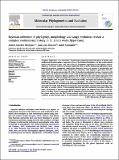Por favor, use este identificador para citar o enlazar a este item:
http://hdl.handle.net/10261/167045COMPARTIR / EXPORTAR:
 SHARE SHARE
 CORE
BASE CORE
BASE
|
|
| Visualizar otros formatos: MARC | Dublin Core | RDF | ORE | MODS | METS | DIDL | DATACITE | |

| Título: | Bayesian inference of phylogeny, morphology and range evolution reveals a complex evolutionary history in St. John's wort (Hypericum) |
Autor: | Meseguer, A.S.; Aldasoro, J.J.; Sanmartín, Isabel CSIC ORCID | Palabras clave: | Phylogeny Bayesian DNA Biogeography Hypericum Character evolution |
Fecha de publicación: | 2013 | Editor: | Academic Press | Citación: | Molecular Phylogenetics and Evolution 67 : p. 379- 403 (2013) | Resumen: | The genus Hypericum L. (> St. John's wort>, Hypericaceae) comprises nearly 500 species of shrubs, trees and herbs distributed mainly in temperate regions of the Northern Hemisphere, but also in high-altitude tropical and subtropical areas. Until now, molecular phylogenetic hypotheses on infra-generic relationships have been based solely on the nuclear marker ITS. Here, we used a full Bayesian approach to simultaneously reconstruct phylogenetic relationships, divergence times, and patterns of morphological and range evolution in Hypericum, using nuclear (ITS) and plastid DNA sequences (psbA-trnH, trnS-trnG, trnL-trnF) of 186 species representing 33 of the 36 described morphological sections. Consistent with other studies, we found that corrections of the branch length prior helped recover more realistic branch lengths in by-gene partitioned Bayesian analyses, but the effect was also seen within single genes if the overall mutation rate differed considerably among sites or regions. Our study confirms that Hypericum is not monophyletic with the genus Triadenum embedded within, and rejects the traditional infrageneric classification, with many sections being para- or polyphyletic. The small Western Palearctic sections Elodes and Adenotrias are the sister-group of a geographic dichotomy between a mainly New World clade and a large Old World clade. Bayesian reconstruction of morphological character states and range evolution show a complex pattern of morphological plasticity and inter-continental movement within the genus. The ancestors of Hypericum were probably tropical shrubs that migrated from Africa to the Palearctic in the Early Tertiary, concurrent with the expansion of tropical climates in northern latitudes. Global climate cooling from the Mid Tertiary onwards might have promoted adaptation to temperate conditions in some lineages, such as the development of the herbaceous habit or unspecialized corollas. © 2013 Elsevier Inc. | URI: | http://hdl.handle.net/10261/167045 | DOI: | 10.1016/j.ympev.2013.02.007 | Identificadores: | doi: 10.1016/j.ympev.2013.02.007 issn: 1055-7903 |
| Aparece en las colecciones: | (RJB) Artículos |
Ficheros en este ítem:
| Fichero | Descripción | Tamaño | Formato | |
|---|---|---|---|---|
| Bayesian inference of phylogeny.pdf | 1,86 MB | Adobe PDF |  Visualizar/Abrir |
CORE Recommender
SCOPUSTM
Citations
69
checked on 14-mar-2024
WEB OF SCIENCETM
Citations
62
checked on 24-feb-2024
Page view(s)
264
checked on 15-abr-2024
Download(s)
1.156
checked on 15-abr-2024
Google ScholarTM
Check
Altmetric
Altmetric
NOTA: Los ítems de Digital.CSIC están protegidos por copyright, con todos los derechos reservados, a menos que se indique lo contrario.
